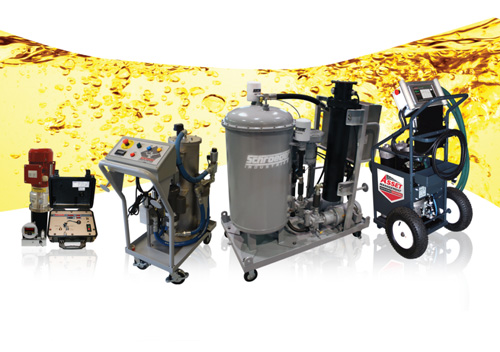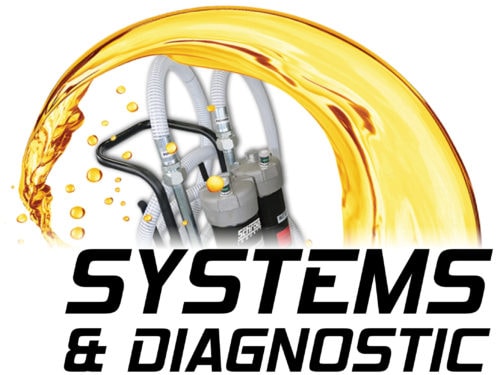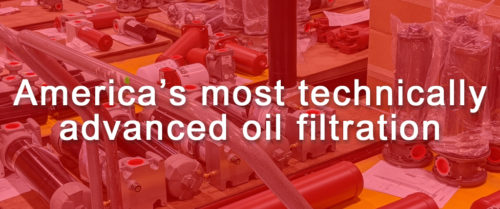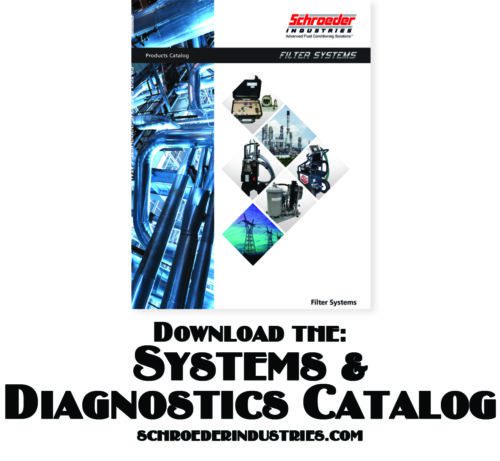What is a Fluid Filtration System?
For a complete listing of Schroeder Industries’ Filter Systems & Diagnostics (IoT), click here.
A fluid filtration system is exactly what it sounds like.
When you think of a typical hydraulic application, the hydraulic filter is normally plumbed in-line with the system (or buried in-line with a hydraulic tank) and serves as an oil conditioning unit when the system is in operation.
Contamination is a leading cause of hydraulic repairs and replacements.
A fluid filtration system, or oil conditioning unit, is a stand-alone unit that operates offline and away from the hydraulic application. Often times in the form of a hydraulic filter cart, it is not to replace any piece of equipment, but to enhance the maintenance team.
Equipped with a pump-motor group of its own, these do not require the power of a hydraulic machine. They are their own system.
Oil conditioning units are typically used for the conditioning of stored fluid, fluid dispensing applications and transferring processes. It is basically summed up that everywhere the fluid is not flowing through a system, it should be accompanied by a hydraulic filter cart.
Request a Quote – Fluid Filtration System
Please include the FS & Diagnostic Tools Fluid Condition and Condition Monitoring Project Application Questionnaire as an attachment below.
Request for Quote
What is meant by “Oil Conditioning”?

With the turn to tighter tolerances in today’s hydraulic critical assets systems, line conditioning equipment has never been more important.
What do we mean when we say “Oil Conditioning”? It is actually quite simple.
Oil Conditioning is using fluid conditioning products such as offline oil filtration and dehydration systems to remove contaminates and increase the moisture removal rate in your hydraulic fluid. Removal of the contaminates and the total moisture allows the system to operate to its fullest potential.
Whether your machine is new or many years old, the cleaner the oil, the better the operating condition.
When contaminants enter a hydraulic system, the manufacturer’s advertised performance of that machine is not achieved.
This adds an increased strain on components such as turbine oil filters, other line conditioning equipment, and more.
Today’s oil conditioning units have seen a shift from “Reactionary” (fix it when it breaks) to “Preventative” (fix it before it breaks), and even “Predictive” (schedule downtime to perform maintenance).
What are Diagnostics Tools?
Similar to a diagnostic OBD II scanner you have for your car, diagnostic tools are the equipment that can recognize and support a “Preventative” maintenance plan.
Bring that into the world of hydraulics and you get equipment similar to the OBD scanner mentioned above.
Only this time, these diagnostics read and report in the form of mineral oil cleanliness.
Watch on YouTube “Diagnostics (IoT)” Playlist.
What do Diagnostics Tools have to do with Oil Conditioning Units? 
When you pair the elite technology found in today’s oil conditioning units with the new-age of the Internet of Things (IoT) technology in most diagnostic tools on the market today, you really step into the future in a real effort of streamlining tedious oil sampling/reporting tasks in a complete system.
The two technologies together are what we like to call proactive “Contamination Control” – taking ownership and managing the fluids you pump into your hydraulic systems day-in and day-out.
“Contamination Control” pertains to the ISO clean analysis and optimization of processes with regard to the cleanliness of components, systems and the purity of the fluids used.
“Contamination Control” is also an important part of operating and maintaining hydraulic systems, like a hydraulic filter cart.
How can Schroeder Industries help?
It starts with the identification and measurement of the different forms of contamination.
Our line of condition monitoring products include both in-line and offline sensors to measure contamination and/or total moisture levels of the hydraulic system.
If the contamination levels are at a certain degree, our end users have seen dramatically frequent equipment failure.
If monitoring is the first step, fluid conditioning products would be the second.
Our line of offline, mobile fluid handling carts are perfect for removing contaminants and increasing overall moisture removal rate from various types of hydraulic fluids.
Oil conditioning units include both mobile fluid handling carts with or without contamination monitoring units, stationary fluid conditioning products from 1.3 gpm flow rates to customizable kidney loop systems up to 140 gpm.
Each of our hydraulic filtration systems are equipped with high efficiency elements to remove solid particulates and/or free water quickly and efficiently.
Our dewatering units, both hydraulic vacuum oil dehydration and mass transfer systems, can remove both free and dissolved water from hydraulic fluids for any reservoir size at various flow rates.
Watch on YouTube “Filter Systems” Playlist.
By implementing fluid condition monitoring equipment, in conjunction with the appropriate filtration equipment, a major portion of particulate contamination introduced during manufacturing and assembly can be effectively and efficiently removed.
The result will be improved fluid condition and consequently extended life expectancy of fluid and equipment resulting in significant cost savings.









